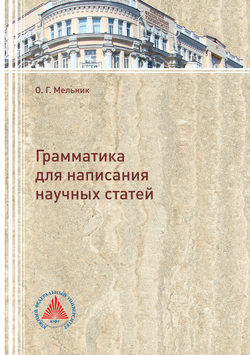Предисловие
Общеизвестно, что в современном глобализированном мире английский язык является своеобразной lingua franca науки, техники и частично образования. Особенно важную роль он играет в научной письменной коммуникации, о чем свидетельствует постоянный рост количества публикаций на английском языке не только в международных, но и в национальных изданиях. Работа с нормами и канонами современного англоязычного научного дискурса и умение представлять свои научные достижения на английском языке очень важны для тех ученых, кто хочет активно общаться со своими зарубежными коллегами и стать равноправными членами международных научно-образовательных сообществ.
Целью пособия "Грамматика для написания научных статей" является отработка основных явлений грамматики английского языки, характерных для научных текстов, а также выработка стратегии овладения научным письмом как видом комплексной деятельности, охватывающей социальные, когнитивные и собственно языковые аспекты.
Потенциальной аудиторией пособия прежде всего являются аспиранты и молодые ученые Южного федерального университета, хотя некоторые его разделы можно использовать в преподавании английского языка как практической дисциплины студентам старших курсов и магистерских программ. Работа с пособием требует достаточно высокой общей англоязычной компетенции, что примерно соответствует уровню знаний и навыков выпускников специализированных групп с углубленным изучением английского языка неязыковых факультетов. Пособие также можно использовать как справочный материал для ученых, стремящихся самостоятельно овладеть основами письменной англоязычной коммуникации. Итак, пособие ориентировано на довольно широкую аудиторию.
Теоретической основой пособия является концепция научного дискурса как социально коммуникативного явления и одновременно как типа текста с рядом сравнительно устойчивых композиционных и языковых признаков. Соответственно, в пособии рассмотрены языковые единицы, способствующие когезии и когерентности научного текста в целом, а не только их отдельные грамматические черты, а также объяснено влияние некоторых социокультурных факторов на особенности организации научного текста.
Lesson 1. What is special about academic English?
I. Grammar
Task 1. Find and correct the mistakes.
1. This failure was occurred for two reasons.
2. Intensity is a significant in stress production.
3. He indicated me that he had decided to always choose the second syllable.
4. I do not agree that conclusion.
5. This experiment focuses the role of pitch.
6. We would suggest to find a better connector piece.
7. After reviewing customer specifications, five main design concepts generated.
8. We talked Terry Larrow.
9. $1500 cost our prototype.
II. Sentence structure
Task 2. Each sentence in the following passage contains one word order error. Rewrite the passage, making corrections as necessary. More than one answer may be possible.
1. Frederick Douglass, an African-American who was born into slavery, for the abolition of slavery fought all his life.
2. He wrote every month articles in the newspaper he established.
3. He used again and again his editorials to try to get his point across.
4. He gave frequently lectures.
5. However, success he did not find immediately.
6. He had to urge constantly president Abraham Lincoln to allow men of his race to enlist in the army.
7. Was very' significant his work for the antislavery movement.
8. Not only he influenced the president, but he also changed the face of the nation. 9. Why there are no campaigners like him today?
III. Academic vocabulary
Task 3. Insert the omitted words.

1. English language 1. _____ is becoming a priority academic/professional requirement whether international higher education graduates choose to return to their home countries or whether they choose to stay in the United States," notes Joan Morley.
2. "English is today the 2. _____language in science and technology, medicine and health care fields, commerce, business and industry, and much more.
3. It should come as no shock to find that three-quarters of the world's information stored in computer banks is in English."
4. According to a recent Wall Street Journal article, a billion persons in the world are able to speak English, with more speaking it as a foreign language than as their mother tongue.
5. But the language that non-native speakers actually speak can be thought of as many different Englishes.
6. Some speak only about computers, or oil, or commodities trading or swine; they, 3._____ English into forms useful for specific purposes, and those who speak these forms are usually unable to 4. _____ comfortably about matters outside their field of interest.
7. Phrases like "get the hang of it," "to go along with," and "getting at," for example, mystify many non-native speakers.
8. 5._____in English can even be deadly.
9. An air traffic controller in Madagascar radioed, "Clipper 1736 report clear of runway."
10. The pilot 6._____ that as clearance for takeoff, rather than an order to report that he had cleared the runway, collided with an incoming airliner, and 600 people died.
11. Such linguistic mistakes have7. _____ at least 3,000 lives, an expert told the Journal.
12. Alan Firth, a British scholar who specializes in foreign 8. _____ of spoken English, told the Journal: "What happens to this language is no longer our 9._____.
13. English is no longer our possession. 14. It's not a monolith. 15. It's in an incredible state of flux."
IV. Punctuation
Task 4. Supply the text with punctuation.
the university of edinburgh unlike other scottish universities is composed of colleges there are three of them sciences and engineering humanities and social sciences and medicine and veterinary medicine each college covers both undergraduate and graduate programmes of study although students are generally admitted to one college only they may have the opportunity to study subjects of another undergraduate programmess generally last three years or four for honours there is an extensive variety of postgraduate programmes of study including a 9 month diploma a 12 month masters and doctoral research programmes lasting at least 36 months
(Grammar for Academic Writing: 1)
V. Formal Style
Task 5. Choose a verb from the list that reduces the informality of each sentence. Note that you may need to add tense to the verb from the list.
assist raise reduce establish create increase investigate determine eliminate fluctuate
1. Expert Systems can help out the user in the diagnosis of problems.
2. This program was set up to improve access to medical care.
3. Research expenditures have gone up to nearly $3,500 million.
4. The use of optical character reader (OCRs) should cut down the number of problems with the U.S. mail service.
5. Researchers have found out that this drug has serious side effects.
6. Building a nuclear power plant will not get rid of the energy problem completely.
7. Researchers have been looking into this problem for 15 years now.
8. This issue was brought up during the investigation.
9. Engineers can come up with better designs using CAD.
10. The emission levels have been going up and down.
VI. Audience
Task 6. Consider the following statements. For whom were they written? What are the differences between the two?
1a. Thermal system is a very broad field involving many separate fields of engineering.
1b. Thermal system is an interdisciplinary field which involves the traditional disciplines of thermodynamics, mass transfer, and chemical kinetics.
Now consider the following. For whom were these written? What are the differences between the two?
2a. Inflation is an abnormal increase in available currency and credit, resulting in a rise in price levels.
2b. An abnormal increase in available currency and credit, resulting in a rise in price levels is called inflation.
Now write a one-sentence definition of a term in your field for two different audiences: one will be students in a totally unrelated field, while the other consists of fellow-students in your own program. Discuss in class how your definitions differ.
VII. Structure
Task 7. Match the question with a title.

VIII. Spelling
Task 8. Find the mistakes.
I have a spelling checker,
It came with my PC.
It plainly marks four my revue
Mistakes I cannot sea.
I’ve run this poem threw it,
I’m sure your please to no.
It’s letter perfect in it’s weigh,
My checker tolled me sew.
(Source unknown)
Task 9. Consider eleven pieces of advice from the list below. Place a check mark (V) before the five most important of them (in your opinion) for a writer of academic texts.
1. Use correct spelling, grammar, and punctuation.
2. Write in an objective, neutral manner.
3. Accurately use the terminology of your discipline.
4. Ensure that your language is rich enough.
5. Write in an academic style, avoid colloquial language, jargon, and slang.
6. Arrange your ideas in a strict logical order.
7. Pay special attention to the introduction of your text.
8. Incorporate visual support (tables, diagrams, graphs) for your ideas.
9. Cite leading papers in your field.
10. Think about the general presentation (chapters, sub-chapters, paragraphs, etc.) of your text.
11. Pay special attention to the conclusion of your text.
Task 10. Here is a list of ten features characteristic of academic writing, five of them are relatively prominent in Anglo-American research texts. Try to find these features in the list.
1. Impersonal style of writing (i.e., without using the personal pronouns "I" or "we").
2. Intensive use of logical connectors (words like "therefore" or "however").
3. Heavy load of terminology and specialized jargon.
4. High degree of formal text structuring (i.e., division of the text into sections and subsections with appropriate headings).
5. Tendency to cite and to include into the lists of references the most recent publications in the field.
6. Frequent occurrence of the phrases which provide reference to the text itself (e.g., "This paper discusses …").
7. Use of long sentences with complicated grammar.
8. Strong emphasis on generalizations and highly theoretical issues.
9. Frequent use of footnotes and long remarks in parentheses.
10. Tendency to follow a certain pattern of textual organization (e.g., problem-solution).
Home assignment:
Academic Vocabulary in Use Unit 1.
Lesson 2. Noun
There are many more nouns than any other part of speech. Since nouns are numerous types in English, you are constantly having to make decisions. For example, you may have to decide if a noun requires a capital letter or not. You may also have to decide if a noun should be in the plural form, and if so, how to form the plural. Most important, in English, you will have to decide if a noun can be counted or not. This distinction can affect of the grammar of a sentence, including which quantity words can occur with a noun.
A. Nouns can be classified as follows:
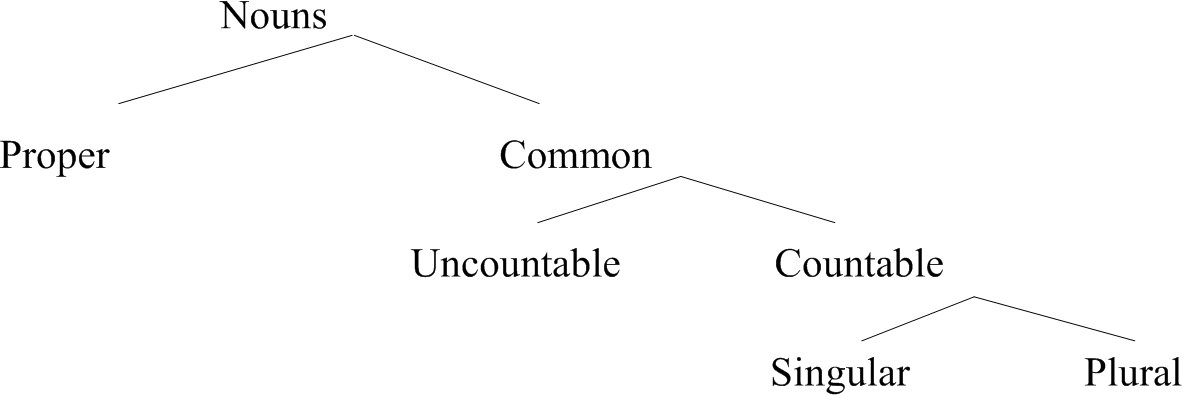
B. Proper Nouns and Capitalization
1. Use proper nouns for the names of specific people or things, including names of countries, languages, nationalities, cities, oceans, rivers, lakes, MI mins, parks, buildings, stores, schools, religions, historical periods of events, styles of art and architecture, months, holidays, and days of week.
2. Always use a capital letter with a proper noun.
My birthday is і a June.
Henry Wright went to Columbia University last September to study French.
Д When a proper noun is accompanied by the definite article the, do not capitalize the article unless it is the first word of the sentence or the first word of a title, such as the title of a book or movie.
The Thames runs through London, past the Houses of Parliament.
3. Use a capital letter with adjectives derived from proper nouns.
She is wearing a sari made of Indian silk.
Capital letters are not used for areas of study (unless you name a specific course), relatives (unless you name a specific person), seasons, or centuries.
He finds biology fascinating. She is taking Biology 101 this semester.
My uncle met me after school. I saw Uncle Jack in the diner.
I can't wait for spring.
She was born in the middle of the twentieth century.
4. Nouns that do not name unique one-of-a-kind places, people, or objects are called “common nouns" Do not use a capital letter with a common noun unless іt is the first word of a sentence. Most nouns arc common nouns. Here are some typical common nouns: bird house happiness essay computer history'
Do not use a capital letter to emphasize a common noun or to suggest that it is important.
My Boss. Mr. Morris, Is giving his Assistant a big Raise.
Task 1. In the following sentences adapted from The Cambridge Encyclopedia of Language, find the proper nouns and capitalize them.
1. Shorthand probably began in ancient greece and rome.
2. The historian xenophon used shorthand to write the memoirs of the philosopher socrutus.
3. Later, a roman, marcus tullius tiro, invented a system to record the speeches made by the great orator cicero.
4. Many people in this period learned shorthand, including julius caesor.
5. In the eighteenth century, because of the industrial revolution, the use of shorthand grew in popularity in business administration.
6. The popularity of shorthand continued to grow in europe with the result that over 400 systems exist for the english language alone.
Countable Nouns and Their Plurals
Countable nouns form one of the two classes of common nouns.
1. A countable noun is a noun that you can count. You can talk about one, two, more, several, many, seventeen, and so on. Countable nouns have a plural form,

A few countable nouns occur in the plural form only and cannot be counted, examples are clothes, pants, Jeans, shorts, and pajamas.
2. The most common way to form a plural countable noun is to add -s or -es, it even when there is a numeral included to signify more than one.

Never add a plural -s ending to an adjective:
"They bought some specials gifts.
3. For countable nouns ending in a consonant + -y, change the -v to -ies.

However, when a vowel precedes -y just add -s for the plural form:

4. Add -es to countable nouns ending in a consonant + -o. For countable nouns ending in -f or -fe, change the ~f to a -v and add -es.

5. Some countable nouns have highly irregular plural forms and do not end in -s.
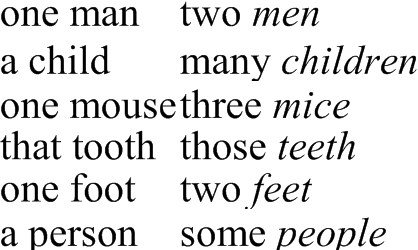
Use your dictionary to check any plural forms that you are not sure of.
6. Very rarely, you need an apostrophe before the -s to form the plural. You do this only when you form the plural of a letter of the alphabet or the plural of a word referred to as a word rather than the concept it represents.
I like to get Q’s in Scrabble.
This paragraph has too many and's in it.
In all other cases, an apostrophe with a noun signals possession, not number.
Task 2. Give the plural form of the following nouns. Use a dictionary to check your answers. Do not rely on general patterns; these often have exceptions.
Foot, house, mouse, woman, goose.
Belief, comedy, donkey, radio, hoof, thief, tomato.
Nouns Keeping Foreign Plurals
Plurals of the nouns of Latin, Greek, and Hebrew origin are often used in English scientific writing even though their English plurals may exist in general use.
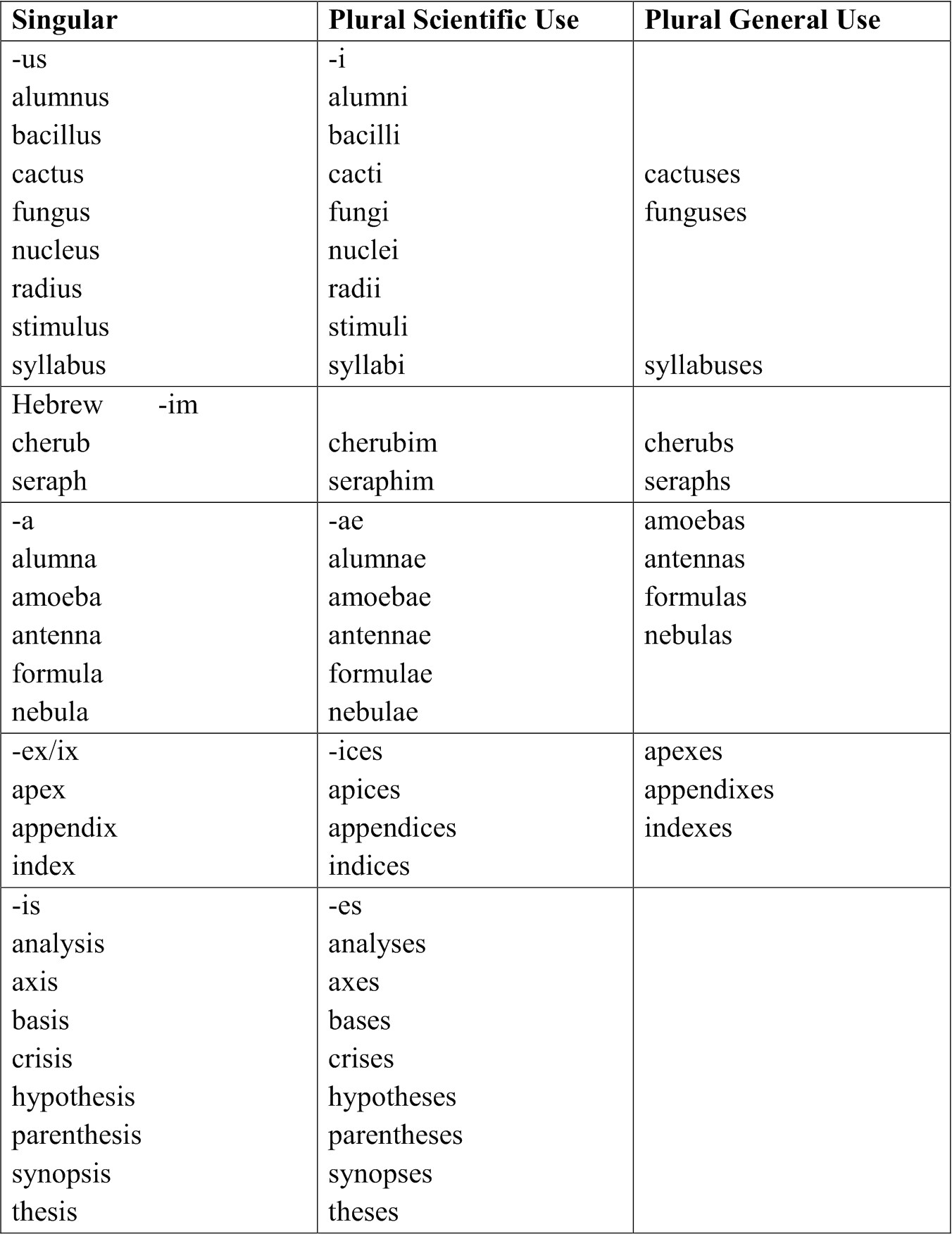
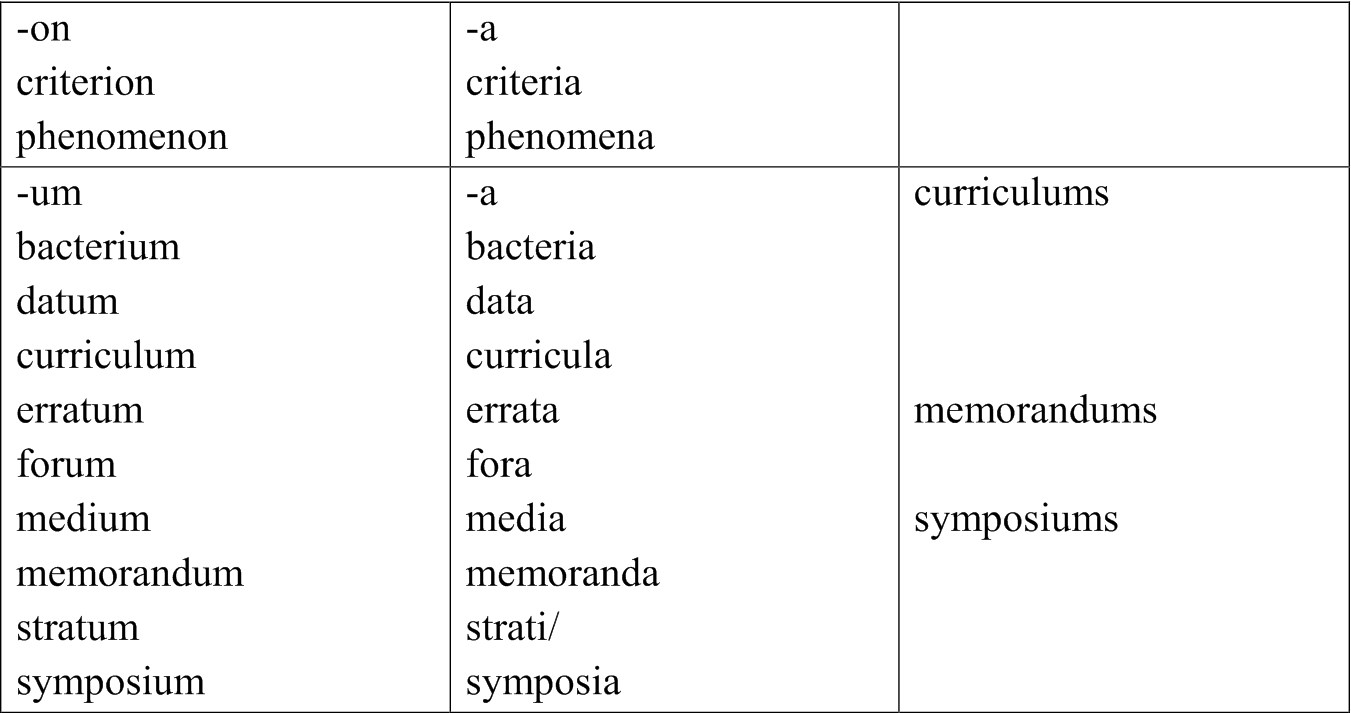
(Academic Writing and Speaking Сourse Pack)
D Uncountable Nouns
Uncountable nouns form the second of the two classes of common nouns.
1. Uncountable nouns are used for nouns describing a mass, a natural substance, food, an abstract concept, a game, a disease, or a subject of study. Some examples follow.
A mass: clothing, equipment, furniture, garbage, homework, jewelry', luggage, machinery, money, scenery, traffic, transportation
A natural substance: air, blood, coal, copper, cotton, hair, heat, ice, iron, silver; water, wood, wool
Food; bacon, beef, bread, coffee, milk, rice, sugar
An abstract concept: advice, courage, education, fun, happiness, health, honesty, information, knowledge, success
A game: checkers, chess, soccer, tennis
A disease: arthritis, diabetes, influenza, measles, smallpox
A subject of study: biology, economics, history, physics, statistics
Countable and uncountable nouns vary from language to language. Also, nouns that are countable in English, such as furniture, information, and hair, may be uncountable in other languages.
Uncountable nouns have no plural form. You can use nouns such as pieces, items.
or bits to indicate exact quantities.
She took a great deal of luggage on her trip, (singular; uncountable)
She took ten pieces of luggage on her trip.
Luggage has no plural form; the countable noun piece is used to indicate the number of items.
Note that even the uncountable nouns that end in -s in the list in item D such as diabetes and physics) are singular and uncountable.
Some countable nouns can be considered as countable or uncountable, depending on the context. Used as an uncountable noun, they refer to the concept in general; used as a countable noun, they refer to a particular one. Uncountable:
Chocolate is fattening. (All chocolate: generalization about a mass noun.)
Countable: He ate a chocolate. (One piece, one serving in a box of chocolates.) He ate four more chocolates.
Uncountable: Life is precious. (Generalization: life as a concept.)
Countable: She leads a busy life. (Specifically the type of life she leads is a busy one. It could be a boring life, a dangerous life, and so on.)
People say that a cat has nine lives.
Task 3. In the context of each of the following sentences, adapted from Panati’s Extraordinary Origins of Everyday Things, indicate in the spaces after the nouns whether they are countable (C) or uncountable (U).
Levi Strauss came to California in the 1850s dining the Gold Rush to make clothes for the miners (-). He knew that they would wear out their clothes quickly, so he made them out of canvas (-), which was used at the time to make tents (-). Later he replaced the canvas with denim – a softer fabric (-) originating from the city of Nimes in (-) France. In Europe this fabric was known as “serge de Nimes" and because of the way (-) it was pronounced, it came to be known as denim in (-) America. Strauss began to dye the miners' pants blue so that stains would not show, and this color increased their popularity (-). To achieve a snug fit cowboys (-) would soak them in water (-), then put them on and lie in the sun to shrink the material (-) as it dried.
(Grammar Troublespots: 81)
E. Quantity words
Some quantity words can he used only with uncountable nouns, with countable singular nouns, or with countable plural nouns. Others can be used with both uncountable nouns and countable plural nouns. Refer to the following chart for correct usage.

Note the difference between few and a few, little and a little. Few and little have a negative connotation and mean hardly any or almost no. A few and it little are positive and mean some.
She has few friends. She has a few friends.
The difference between few and a few means that the two sentences above must be continued in different ways.
She has few friends, so she stays home most weekends.
She has a few friends, so she often goes out with them on weekends.
Use not with any. Use no and none alone.
Where are the screwdrivers? I don't have аnу. I have no screwdrivers. I have none.
In standard English, do not use two negative expressions in a clause,
He doesn't have no toots. He doesn't have none.
Task 4. The student who wrote the following paragraph made mistakes with nouns, plurals, and quantity words. Correct the errors.
My best Friend and I wanted to take another trips to Europe and africa, but we didn't have many money. When I saw my two ancient Suitcase, I knew it was lime to buy some new luggages. I looked in the windows of all the store in the center of Town. But all I saw was clothing. I tried on three dress, but і didn't buy one. At last. I saw a wonderful bag made of spanish leather, but it was very 'expensive and I didn't have no money. I decided to go shopping other day.
Task 5. Identify the sentences with a mistake and correct it.
1. A number of U.S. lecturers comes to our University next week.
2. Critically he studied the article on transgenic food products.
3. As the annual report of the Mesa Garden states, these cactuses grow exclusively in the northern parts of Mexico.
4. Either the journalist or the witness know the truth about this mysterious event.
5. Elaborated will be in this paper the model of corrosive destruction of metals under lacquer-paint coatings.
6. The teacher asked the students if they knew the health effects of insecticides.
7. The premises of the library is cleaned every day.
8. Twenty dollars are not enough to buy this book.
9. Many mathematical symposiums are held in Europe every year.
10. Bile acids contains significant amounts of cholesterol.
11. This extremely interesting new Ukrainian historical novel has been favorably reviewed.
12. In no ease the work on the project will be terminated.
This + Summary Word
A good way to maintain flow is to use this/these + a noun to join ideas together, e.g.: English language instructors know that students need to understand the difference between formal and informal language. However, this understanding cannot usually be acquired quickly.



